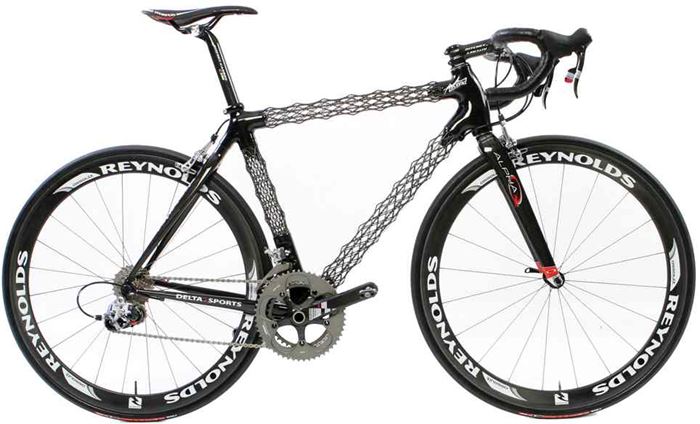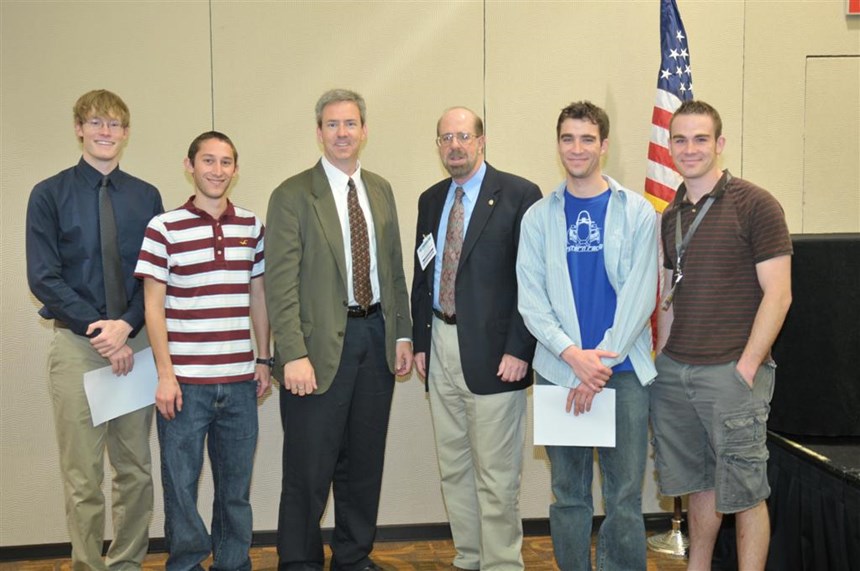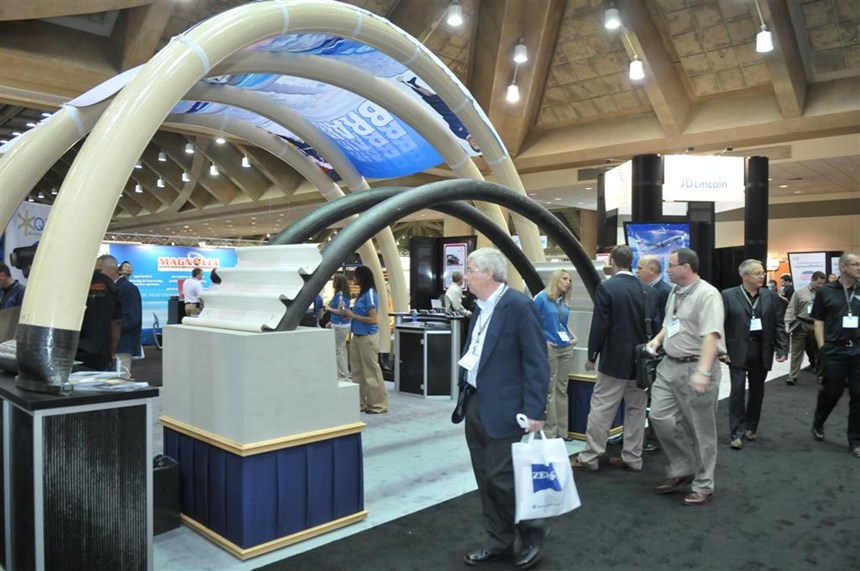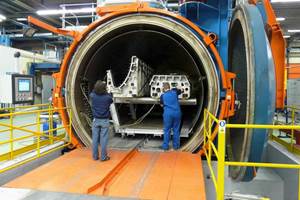SAMPE 2009 Product Showcase
Showgoers at the SAMPE 2009 Conference and Exhibiton in Baltimore, Md. found many suppliers undeterred by poor economic news.
The mood on the show floor at the 2009 editions of the SAMPE Conference and Exhibition (May 18-21, Baltimore, Md.) was surprisingly positive: Although attendance this year did not equal 2008 levels at either event, turnouts were better than expected, given the global economic recession. Postshow statistics released by show organizers tended to support that contention. The official tally ran to 250 exhibiting companies and 3,300 attendees.
Aircraft industry buoys Baltimore expectations
Back in Baltimore as part of the show’s alternating East Coast/West Coast schedule, SAMPE 2009 faced on big question from showgoers: “How will the down economy affect the event?” Although the recession has left no end market unaffected, the aerospace segment has felt less impact than the automotive or marine sectors, so composites manufacturing professionals in the SAMPE aisles tended toward cautious optimism. While the show could not match the energy of past years’ events, there was still much discover on the show floor and discuss in conference sessions. It helped that the thrice-delayed Boeing 787 Dreamliner was, at show time, little more than a month away from its first flight. And much show-floor talk centered on suppliers efforts to ramp up for anticipated service on the forthcoming Airbus A350 XWB.
On the SAMPE 2009 show floor, exhibitors were out in force, touting new technologies and showing little evidence that the recession is discouraging development. Consequently, our HPC operatives found much to report.
Customizable flat fabric from braid
A&P Technology (Cincinnati, Ohio) presented its new QISO quasi-isotropic single-layer balanced fabric, at SAMPE’s Presentation Stage on the show floor. Made by slitting a braid, the fabric is bonded with a small amount of thermoplastic binder along the edges to prevent fraying, and binder can be added to the width for special applications, for example, for small cutouts. The company says QISO is completely customizable: fabric widths, braid angles, and fiber types can be customer-specified for part or tooling applications.
Water-soluble mandrel material
Advanced Ceramics Manufacturing (Tucson, Ariz.) showed its Rapid Mandrel Development Process, the company’s next-generation water-soluble mandrel technology for hollow composite parts. The system, based on the company’s original ceramic chemistry but with reportedly much improved properties, creates a mandrel to customer specifications directly from CAD data. Specific properties (e.g., strength) can be customized to meet the needs of an application and, says the company, can be done on a fast-turnaround basis. Completed mandrels are delivered ready to use, in sealed, moisture-proof packaging. Wash out after cure is said to be a matter of minutes.
Top paper, three-year supply pact
Advanced Composites Group Inc.’s (Tulsa, Okla.) VP of technology Chris Ridgard presented a paper on out-of-autoclave manufacturing and production technology. His presentation was well-received and the technical paper on which it was based was voted one of SAMPE 2009’s most outstanding. The company also highlighted its three-year supply agreement with Southern Spars (Auckland, New Zealand) to supply MTM prepreg for carbon fiber spars and rigging and attainment of ISO TS 16949 market accreditation from Lloyd’s Register for automotive industry applications.
High strength-to-weight lattice structure
Advanced Composite Solutions (Payson, Utah) touted its IsoTruss production process, which organizes filament-wound carbon fiber towpreg organized into a tubular lattice design that results in a rigid structure of customer-selected diameter and length with an extremely high strength-to-weight ration. On display was a bike frame featuring the IsoTruss carbon fiber, but company COO Brent Johnson reported that the firm is evaluating replacement of wind turbine towers. In the works: A proof-of-concept tower in Utah that is 280 ft/85.3m tall and 18 inches/457 mm in diameter. The use of the lattice framework allows the company to use compression calculus to “dial in” global and local buckling properties (depending on failure modes), thus allowing an increase in diameter with minimal increase in mass. Further, the design allows the rest of the truss to pick up stress caused by failure of a truss node. More expensive than traditional steel, the IsoTruss tower is expected to be would easier to install and have a longer service life.
Image analysis systemsCarl Zeiss Microimaging Inc. (Thornwood, N.Y.) attracted attention at its large display of the company’s specialty microscopes and image analysis systems that can be applied to composite material testing. Many large aerospace companies use the systems to document coupon testing, failure analysis and stress testing of composite materials, says the company. On display was the range of imaging equipment available, including EVO MA and LS Series scanning electron microscopes (SEM) for nanoscale imaging.
Portable cleanroom for composite repair
Cornerstone Research Group (Dayton, Ohio) attracted attention for its innovative research and products. In addition to its Passive, Adaptive Structures, which involve design and materials that allow a structure to adapt its shape under changing load conditions, the company displayed its new, trademarked DIRT Bag (for Deployable Isolation Repair Technology). A portable, deployable clear plastic cylinder with hand ports, it allows a repair team to isolate a damaged area and enables technicians to perform field repairs in a clean environment. The bag can be fitted with vacuum ports, allows for electrical cord and hose access and adheres to the substrate, effectively creating a small, portable cleanroom for composite layup, repair and curing.
Cost-efficient production of tooling
CTS Composites Inc. (Mississauga, Ontario, Canada) showed its range of mold tools for composites. The company produces a line of resin infused tools, finished with a durable surface coating. Tools can be produced in less time at lower cost, yet deliver excellent performance, the company claims. Also on display: tools made with Huntsman Advanced Materials (The Woodlands, Texas) REN paste, now capable of service curing temperatures between 350° and 400°F (177°C and 204°C).
New facility speeds PMI foam delivery
Evonik Foams – ROHACELL (Magnolia, Ark.) celebrated the opening of its new North American manufacturing facility in Mobile, Ala., pointing out that the plant reduces delivery times for ROHACELL high-performance polymethacrylimide (PMI) foam material for major aerospace customers, such as Bell Helicopter Textron in Ft. Worth, Texas. Parent company Evonik Industries also announced that it now manufactures polyetheretherketone (PEEK) powder for composite materials.
Simulation software distribution partnership
Firehole Technologies Inc. (Laramie, Wyo.), a provider of advanced composite analysis and simulation tools, announced at SAMPE a partnership with SmartCAE (Prato, Italy) to market and sell Firehole’s Helius brand of advanced composites simulation software. SmartCAE is the first company chosen as a Firehole Certified Reseller. Firehole also reports that it is near completion of development of an ANSYS-compatible version of its Helius software.
International trade award winner
General Plastics Mfg. Co. (Tacoma, Wash.) revealed that it recently won the prestigious Globe Award for 2009, given by the State of Washington Trade Council to a company that demonstrates it has expanded its international trade capacity and provided benefit to the local economy. Company president Floyd Henry accepted the award on May 21 on behalf of General Plastics’ employees. Reporting positive growth in these tough times, the company recently appointed Barentz Europe B.V. (Hoofddorp, The Netherlands) as distributor of its high-density polyurethane foam products to more than 40 countries in Europe.
Coating for corrosion-prevention
Henkel (Rocky Hill, Conn.) demonstrated its line of structural adhesives, peel plies, surfacing films, syntactic core and repair resins, along with its well-known Frekote mold release. The company unveiled the development and approval of its new trademarked Alodine 871 Touch-n-Prep trivalent chromate-based touch-up coating, to U.S. military specification MIL-DTL-81706B. The coating, used to repair bare areas of metal surfaces to prevent corrosion, comes in a ready-to-use pen applicator for easily delivering the coating directly onto the surface. Structural adhesives can be applied directly to it, without rinsing, for composite-to-metal applications.
Chemical-resistant epoxy adhesive
Huntsman Advanced Materials (The Woodlands, Texas) came to the show with a new series of resin systems. Araldite EP1000 A/B, a heat-resistant, nano-toughened, two-part structural epoxy adhesive is a two-part thixotropic paste with a 2:1 mix ratio and low viscosity. This epoxy cures at temperatures ranging from ambient to 212°F/100°C, does not requires autoclave cycling, and reportedly maintains more than 90 percent of its shear strength after exposure to aviation fuels and hydraulic fluids and retains 25 to 30 percent of its physical properties at temperatures as high as 300°F/150°C.
Manufacturing capabilities on display
ICE (Innovative Composite Engineering, White Salmon, Wash.) created a buzz at its booth with its display of a complete ScanEagle unmanned aerial vehicle. The company produces the wing parts for the joint Boeing and Insitu Inc. (Bingen, Wash.) ScanEagle system, in addition to a wide variety of composite tubes for structural applications, fabricated via table rolling and compression/bladder molding.
PU foam and end-grain balsa coreI-Core Composites LLC (Cullman, Ala.) showed its lines of polyurethane structural foam and end-grain balsa core panels for composites. Its CORRITE polyurethane foam is intended to replace crosslinked PVC foam cores. The product’s very small cell size minimizes resin uptake. The material has high temperature resistance and is compatible with virtually all resin systems, says the company. Its EG Balsa ARMOR end-grain balsa product incorporates a biocide to inhibit bacteria, mold and fungi. Both products are available in both rigid and contourable sheets, and other specialized forms for specific applications. Contouriable panels are cut blocks held together by the company’s trademarked Plyscrim backing). The company contends that the Plyscrim 100 backing scrim on its balsa core is more open and, therefore, affords a better bond with sandwich panel faceskins than do the scrims used on competing products.
Laser-ply projection system
LAP Laser (Cincinnati, Ohio) brought to the show its laser projection systems for fabric placement guidance. LAP’s newest projector can project up to four different images/CAD drawings using an optional software feature ($3,000) that saves the user the cost of investment in a whole new projector. The company also offers with its projectors a text editor that provides projection of text on the tool showing ply name and other user-determined information.
Filament winding design services
MATERIAL SA (Brussels, Belgium) together with its U.S. distributor and representative Skinner Creative Inc. (Draper, Utah) showcased its software and design services for filament winding and composites, including its CADWIND software for creating winding patterns and CompositeStar software for laminate design. The company showcased the work of a customer in Norway that, with the aid of CADWIND, can produce small filament-wound pressure vessels on a 20-spindle machine at a rate of one tank every five minutes, or more than 800,000 tanks per year.
Thermal testing instruments
Netzsch Instruments Inc. (Burlington, Mass.) showed its range of instruments for measuring thermal properties of composites. On display was the company’s newest Simultaneous Thermal Analyzer, the STA 449 F1, capable of simultaneous differential scanning calorimetry (DSC) and thermogravimetric analysis (TGA). The machine features dual-furnace capability, an automatic sample changer and quick-change sensors. The company also offers instruments for thermal conductivity/thermal diffusivity of composites. Contract testing services for customers are available.
Truss-reinforced core for closed molding
Nida-Core (Port St. Lucie, Fla.) exhibited its recently unveiled NidaFusion SXO/SXF, a three-dimensional, quasi-isotropic, tufted closed molding core with fiberglass facings designed for sandwich construction applications where isotropic properties are highly desirable (e.g., wind turbine blades). The z-directional tufted threads give the material some flexibility for layup, and when infused with resin, they form a pyramidal truss network inside a closed cell foam for high strength. Also on display: a new polyethylene terephthalate (PET) Nida-Foam family made entirely of recycled plastic, intended for architectural, wind energy, marine and transportation markets. The company also distributes a unique honeycomb foam core product, termed 3D Core, with scored channels around each cell, which make the core pliable and conformable, and form resin channels during infusion. When cured, the resin forms the cell “walls” around the foam cells, creating a foam-filled honeycomb composite with very high shear, flexural and compression strengths.
Precision toolmaking capabilities
North Coast Companies (Cleveland, Ohio) exhibited a large resin transfer molded (RTM) aircraft rudder, with six integrally molded ribs, spars and comolded skin with lightning strike protection. Made in an oil-heated steel mold designed and built by North Coast Tool & Mold and containing features to ensure full wetout, the part with its interior features was molded to within 0.010 inch of nominal design dimension, says the company, as confirmed by measurements. The rudder is being produced by North Coast Composites.
Aerospace contractor Nadcap-certified
Quatro Composites (Orange City, Iowa and Poway, Calif.) highlighted its recent Nadcap Accreditation for Composites certification, which signifies that the Iowa manufacturing facility complies with all Nadcap standards. These include prepreg/adhesive bonding, resin film infusion and core processing. Nadcap is a worldwide cooperative program of aerospace industry prime contractors that governs precise standards used to measure the competency, capability and consistency of suppliers and associated products within the aerospace industries.
Polyimide selected for allowables database testing
Renegade Materials Corp. (Springboro, Ohio) highlighted its popular MVK-14 FreeForm TM polyimide resin prepreg product, which was recently selected by the airframe and propulsion structures community, for allowable-database testing at the National Center for Advanced Material Performance (NCAMP) at the National Institute for Aviation Research (NIAR, Wichita, Kan.), funded by the U.S. Air Force Research Laboratory Composite, Wright-Patterson AFB. The high-temperature resin is reportedly an affordable alternative to bismaleimides or titanium materials in demanding high-temperature applications such as jet engine components and hot airframe structures. The material is not-ITAR controlled, and the NCAMP test database and qualification will make it easier for airframe and propulsion manufacturers to specify the material in military and commercial aerospace programs.
Versatile meter/mix/dispense system
Sealant Equipment & Engineering Inc. (Plymouth, Mich.) introduced Servo-Flo 505, a fixed-ratio, positive rod displacement, meter-mix dispense system for robot-applied applications of low- to high-viscosity two-component epoxies, acrylics, silicones and urethanes in the production and assembly of composite components. The system’s control panel and supply can be floor-mounted, mobile-cart mounted or integrated by the manufacturer with a robot dispensing system. It has three levels of electronic controls (basic, intermediate and advanced) available to handle any production dispensing application, including manual applications. It offers 254 preset dispensing sequences, each of which offers a different flow rate for bead diameter or filling speed per part.
Multiaxial fabric preforms
SIGMATEX High Technology Fabrics Inc. (Benicia, Calif.) had its multiaxial fabric technology on display, which includes the ability to produce very lightweight multiaxial fabrics with spread fiber tows, unique in the U.S. Expert Christopher McHugh presented a technical paper regarding the creation of three-dimensional woven carbon fiber fabrics using current design and manufacturing methods. The company showed an expandable, one-piece woven structure designed and made on a Jacquard loom that can be expanded and used as a preform for a three-dimensional part, essentially a woven carbon fiber honeycomb that could eliminate complex layup.
Boron, carbon monofilment & SiC fibers
Specialty Materials Inc. (Lowell, Mass.) showed its unique fiber products, including boron fiber and its carbon monofilament, which it now offers in large quantities of 1 million linear ft (304,800m) or more. While the company uses this material as a substrate for the manufacturing of its SCS silicon carbide fibers, applications are emerging for the very fine monofilament. In addition, the firm also announced that it has reduced the price of its SCS silicon carbide (SiC) fibers by 12 percent for volumes of at least 500 lb/226.8 kg annually.
Toolmaking collaboration
Surface Generation (Oakham, Rutland, U.K.) announced at SAMPE that it has formed a partnership with Reno Machine Co. Inc. (Newington, Conn.) whereby Reno will machine and manufacture molds built using Surface Generation’s reconfigurable, machinable pin-tool system. The pins, available in widths of 1 to 20 inches (25.4 to 508 mm), are said to be accurate to within 0.000001 inch and feature integrated heating/cooling channels that allow the tool to be heated from ambient temperature to 800°F/427°C and back to ambient in 12 minutes. The pins can be made from any metal, the company reports, and can be easily machined or replaced to accommodate dimensional changes in a part or structure. The tooling system can be used with autoclaved prepreg, or used in compression molding and injection molding processes.
Composite manufacturer repositions for growth
Swift Engineering Inc. (San Clemente, Calif.) confirmed at the show that the intellectual property of its Killer Bee unmanned aerial vehicle (UAV) has been sold to Northrop Grumman (Los Angeles, Calif.). Swift, however, continues to manufacture the aircraft. Swift also reports that it has recently shipped 24 race cars that feature all-carbon composite body/chassis construction; they will be driven in the Formula Nippon auto racing series. The company also says it is pursuing opportunities in the design and optimization of wind blades.
Wet-laid carbon nanofiber veil
Technical Fibre Products Inc. (Newburgh, N.Y. and Kendal, Cumbria, U.K.) presented a technical paper at the conference regarding its work with incorporating carbon nanofibers into nonwoven veil materials, for greater functionality. Its results show that carbon nanofiber (CNF) materials added to wet-laid nonwovens can vastly improve properties such as EMI shielding or z-direction conductivity, for instance, depending on the fibers use and the degree of CNF loading.
Aerospace prepreg for dimensional stability
TenCate Advanced Composites USA (Morgan Hill, Calif.) used the show as an opportunity to launch a new prepreg for satellite structures. TC410 cyanate ester prepreg resin system is a new-generation material that addresses the need for dimensional stability in optical benches, reflectors and other satellite structure. The prepreg utilizes a fairly low cure temperature (250°F/121°C) but exhibits extremely low moisture absorption, which reduces residual stresses in the composite parts when they are exposed to thermal cycles in space.
Bleeder and breather cloths
A relative newcomer to the composites industry, The Warm Co. (Lynnwood, Wash.), brought to the show its line of bleeder and breather cloths. These 100 percent virgin polyester, needle-punched cloths are available in multiple weights and are functional at temperatures up to 260°C/500°F. Selected cloths feature integrated silica to provide fire retardant properties.
High-temp platens for compression molding
Heated platen specialist Venango Machine Co. (Wattsburg, Pa.) reports that it’s seen a slight uptick in composites industry business as some smaller parts are migrated out of the autoclave and into the compression molding environment. Further, the company is seeing a trend toward high-temperature composite materials, increasing demand for more robust, high-temperature platens with good temperature uniformity. The latter is required, says sales manager Nyla Vogel, to reduce scrap and optimize use of high-cost materials.
Tooling for out-of-autoclave processes
Weber Manufacturing Technologies Inc. (Midland, Ontario, Canada) exhibited its capabilities for out-of-autoclave processing with its tooling technology that incorporates integral oil heating and steel inserts behind a nickel vapor deposition (NVD) mold face for rapid temperature response, producing net-shape carbon fiber parts produced with vacuum bag processing, without an autoclave. The company has produced tools for Class A automotive prepreg parts as well as resin-infused truck hoods for a military vehicle.
Reinforcement binder for layup
Zyvax Inc. (Ellijay, Ga.), well-known for its mold release products, brought to SAMPE a new product called StayZ Spray Interface, an adhesive designed for the temporary placement of lamination materials that provides a permanent, seamless bond once cured. It’s formulated for use in all prepreg and infusion manufacturing processes. It’s a single-component material, heat cured, with good bond strength to metal, glass, carbon and other synthetic laminates. It reportedly prevents displacement of the resin matrix while providing good tack. Initial tack occurs in 2 minutes, and it’s tack-free in 30 minutes at room temperature. Cure is 30 minutes at 130°C/266°F or 15 minutes at 150°/302°F.
Carbon nanotube-enhanced prepregs
Zyvex Performance Materials (Columbus, Ohio) reports increasing success finding applications for its carbon nanotube-enhanced prepregs. According to business development director Russell Belden, the company is working with boatbuilder Strategic Composites (Pacific, Wash.) to develop a boat designed to make use of the product. The company emphasized the total system-cost reductions — weight savings, CO2 reduction, increased fuel efficiency, etc. — possible through use of its products. It also has redesigned the traditional wind turbine to maximize carbon nanotube use: It features the turbine works at the tower base, connected to a long-life carbon fiber rotor at the top by a carbon fiber driveshaft.
Related Content
Plant tour: Spirit AeroSystems, Belfast, Northern Ireland, U.K.
Purpose-built facility employs resin transfer infusion (RTI) and assembly technology to manufacture today’s composite A220 wings, and prepares for future new programs and production ramp-ups.
Read MorePlataine unveils AI-based autoclave scheduling optimization tool
The Autoclave Scheduler is designed to increase autoclave throughput, save operational costs and energy, and contribute to sustainable composite manufacturing.
Read MorePlant tour: Airbus, Illescas, Spain
Airbus’ Illescas facility, featuring highly automated composites processes for the A350 lower wing cover and one-piece Section 19 fuselage barrels, works toward production ramp-ups and next-generation aircraft.
Read MoreVIDEO: One-Piece, OOA Infusion for Aerospace Composites
Tier-1 aerostructures manufacturer Spirit AeroSystems developed an out-of-autoclave (OOA), one-shot resin infusion process to reduce weight, labor and fasteners for a multi-spar aircraft torque box.
Read MoreRead Next
VIDEO: High-volume processing for fiberglass components
Cannon Ergos, a company specializing in high-ton presses and equipment for composites fabrication and plastics processing, displayed automotive and industrial components at CAMX 2024.
Read MorePlant tour: Daher Shap’in TechCenter and composites production plant, Saint-Aignan-de-Grandlieu, France
Co-located R&D and production advance OOA thermosets, thermoplastics, welding, recycling and digital technologies for faster processing and certification of lighter, more sustainable composites.
Read More“Structured air” TPS safeguards composite structures
Powered by an 85% air/15% pure polyimide aerogel, Blueshift’s novel material system protects structures during transient thermal events from -200°C to beyond 2400°C for rockets, battery boxes and more.
Read More
















.jpg;maxWidth=300;quality=90)







